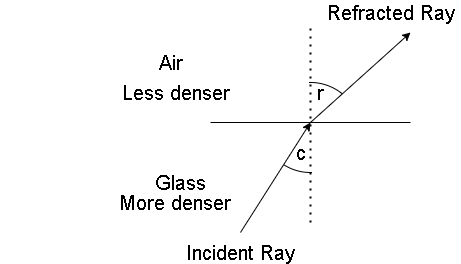
A crack in a glass vessel often shines like a mirror because of:
A) Total reflecting surface
B) Reflection
C) Refraction
D) All
Answer
490.8k+ views
1 likes
Hint:A phenomenon in which the rays of light travel from a denser medium to a rarer medium is known as total internal reflection. This phenomenon occurs when there are two mediums. In this problem, this concept will be used.
Complete step-by-step answer:
Step I:
When a ray of light enters from a denser medium to a rarer medium, the angle of incidence should be greater than the critical angle. The critical angle in total internal reflection is the angle of incidence, at which the angle of refraction is

Step II:
Given that there is a crack in the glass vessel, so two mediums will be there. One medium is glass and the other medium is air. This is because the air rushes in, from the crack in the vessel. Since glass is more denser than the air, so the light rays travelling from glass to air will suffer total internal reflection at the critical angle.
Step III:
In case when the two mediums are glass and air, when the angle of incidence is greater than
Therefore, option A is the right answer.
Note:The critical angle is basically the angle of incidence beyond which the rays of light passing from a denser medium to a rarer medium will not refract. They will completely suffer reflection instead of refraction. The value of critical angle can be calculated using Snell’s law. While using Snell’s law, the value of angle of refraction should be
Complete step-by-step answer:
Step I:
When a ray of light enters from a denser medium to a rarer medium, the angle of incidence should be greater than the critical angle. The critical angle in total internal reflection is the angle of incidence, at which the angle of refraction is

Step II:
Given that there is a crack in the glass vessel, so two mediums will be there. One medium is glass and the other medium is air. This is because the air rushes in, from the crack in the vessel. Since glass is more denser than the air, so the light rays travelling from glass to air will suffer total internal reflection at the critical angle.
Step III:
In case when the two mediums are glass and air, when the angle of incidence is greater than
Therefore, option A is the right answer.
Note:The critical angle is basically the angle of incidence beyond which the rays of light passing from a denser medium to a rarer medium will not refract. They will completely suffer reflection instead of refraction. The value of critical angle can be calculated using Snell’s law. While using Snell’s law, the value of angle of refraction should be
Latest Vedantu courses for you
Grade 11 Science PCM | CBSE | SCHOOL | English
CBSE (2025-26)
School Full course for CBSE students
₹41,848 per year
Recently Updated Pages
Master Class 4 Maths: Engaging Questions & Answers for Success

Master Class 4 English: Engaging Questions & Answers for Success

Master Class 4 Science: Engaging Questions & Answers for Success

Class 4 Question and Answer - Your Ultimate Solutions Guide

Master Class 11 Economics: Engaging Questions & Answers for Success

Master Class 11 Business Studies: Engaging Questions & Answers for Success

Trending doubts
Give 10 examples of unisexual and bisexual flowers

Draw a labelled sketch of the human eye class 12 physics CBSE

Differentiate between homogeneous and heterogeneous class 12 chemistry CBSE

a Tabulate the differences in the characteristics of class 12 chemistry CBSE

Why is the cell called the structural and functional class 12 biology CBSE

Differentiate between insitu conservation and exsitu class 12 biology CBSE




